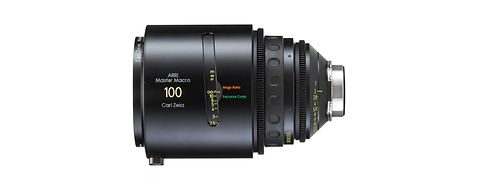Technical Data
| Name | Master Macro 100/T2.0 |
Type (1) | Makro-Planar T* XP |
Lens Mout (2) | PL LDS |
Aperture (3) | T2.0/T4.3 to T32 |
Close focus (4) | 0.35 m / 13 3/4" |
Magnification ratio (5) | 1:1 |
Length (6) | 202,7 mm / 8" |
Horizontal angle of view ANSI Super 35 (8) ID = 31.14 mm (11) | 14.02° |
Horizontal angle of view DIN Super 35 (9) ID = 30.00 mm (11) | 13.52° |
Horizontal angle of view Normal 35 (10) ID = 27.20 mm (11) | 12.42° |
Entrance pupil (12) | 77.1 mm / 3" |
Maximum Housing Diameter | |
Front diameter (7) | 114 mm / 4.5" |
Weight | 2.6 kg / 5.7 lbs |
Item number meter | K2.47572.0 |
Item number feet | K2.47573.0 |
(1) T* XP is the trademark of the ZEISS anti-reflection lens coating that significantly reduces veiling glare and other internal reflections. XP stands for extended performance.
(2) Positive locking 54 mm stainless steel lens mount with Lens Data System (LDS) contacts
(3) Maximum aperture at infinity is T2.0, at close focus T4.3
(4) Close focus is measured from the film/sensor plane
(5) Magnification ratio is the relationship of the size of an object on film (first number) to the size of that object in real life (second number)
(6) Lens length is measured from the lens mount to the front of the lens housing
(7) Diameter of the lens/matte box interface. Maximum lens housing diameter for the Master Macro 100 is 138 mm.
(8) Horizontal angle of view for an ANSI Super 35 Silent camera aperture (aspect ratio 1.33:1, dimensions 24.9mm x 18.7mm / 0.980" x 0.7362")
(9) Horizontal angle of view for a DIN Super 35 Silent camera aperture (aspect ratio 1.33:1, dimensions 24mm x 18mm / 0.944" x 0.7087")
(10) Horizontal angle of view for a Normal 35 Academy camera aperture (aspect ratio 1.37:1, dimensions 22mm x 16mm / 0.8661" x 0.6299")
(11) The image diameter (ID) is the diameter of the image circle needed for the respective format. The Master Macro 100 is designed for the largest ID given here (ANSI Super 35).
(12) The distance from the entrance pupil to the film/sensor plane. Positive numbers indicated an entrance pupil in front, negative numbers indicated an entrance pupil behind the film/sensor plane. The entrance pupil (often mistakenly called "nodal point") is the center of perspective; moving the camera/lens system around the center of the entrance pupil prevents parallax errors. While largerly irrelevant for live action, this measurement is important for special effects work.
